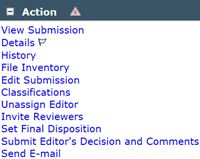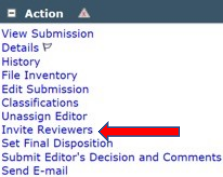Individuals interested in serving as Guest Editor for Photogrammetric Engineering & Remote Sensing (PE&RS) should adhere to the following guidelines. Please refer all questions to the Editor-in-Chief Dr. Alper Yilmaz (PERSeditor@asprs.org).
Background
Special Issue manuscripts are peer-reviewed and will address a specific theme proposed by the Guest Editors. It typically takes 9-12 months to bring a Special Issue of PE&RS to publication.
In most cases, peer-reviewed manuscripts will be limited to nine journal pages per final article. Additional journal pages will be assessed an extra page fee. A 34-page manuscript (including tables and figures) prepared according to PE&RS Instructions for Authors, equals about nine journal pages. Authors of published manuscripts will be charged $150/page extra page fee for each page exceeding nine journal pages. These page charges must be paid before publication, without exception.
Initial Approval
Individuals wishing to propose a theme for a Special Issue and/or who wish to serve as Guest Editor for such Special Issues must contact PE&RS Editor-in-Chief Alper Yilmaz for approval before proceeding. To facilitate consideration of such requests a short written proposal should be prepared and emailed to Alper Yilmaz. This proposal must include your contact information, the specific subject of the Special Issue, a short justification of why this should be a Special Issue, and any other pertinent information including deadlines, topics of interest under the proposed theme, and the names of the guest editors along with their contact information.
Call-for-Manuscripts
Special Issues of PE&RS are occasionally comprised entirely of invited manuscripts but more often manuscripts are solicited through an open call-for-manuscripts. Sample calls-for-manuscripts can often be found on the ASPRS web site (www.asprs.org) or can be found in past issues of PE&RS. A draft call-for-manuscripts should be sent via e-mail to the Editor-in-Chief. At a minimum, the call-for-manuscripts must include:
- the theme of the Special Issue and identification of topics of special interest;
- the name and contact information (including e-mail fax and telephone number) of the Guest Editor;
- The important dates: manuscripts due, decision to authors, final manuscripts due, publication date; and,
- a statement that all manuscripts are to follow the PE&RS Instructions for Authorsthat are published in each issue of the Journal and are available on the ASPRS website.
After the call-for-manuscripts is approved it will be published in the appropriate issue of PE&RS and on the ASPRS web site.

Receipt of Manuscripts
As manuscripts are received the Guest Editor will notify authors that their manuscript has been received and subsequently will keep authors informed on the status of the review process. The Guest Editor will do an initial review of each manuscript to determine if it is appropriate for the Special Issue. If it is not suitable for the Special Issue, yet the manuscript is worthy of publication, the Guest Editor will transfer the manuscript to the Editor-in-Chief as a regular submission.
Manuscripts suitable for the Special Issue must have a cover letter that is modified from the Sample Cover letter on the ASPRS website. The Guest Editor will make sure the cover letter:
- has the name (title full first name and last) affiliation and email address for not only the corresponding author but for all the non-corresponding authors.
- indicates that the manuscript reports on original work that the manuscript has not been submitted for publication elsewhere.
- indicates that the authors agree to pay for any pages over the nine pages limit.
- indicates that the authors are willing and able to pay for any color figures.
Finally, if the Guest Editor feels a figure should or should not be color this should be discussed with the author before the manuscript goes out for review. Once a manuscript is accepted any color figures must be printed in color and any black and white figures must be printed as black and white.
The Guest Editor will use Editorial Manager which is the online system used by PE&RS to keep track of all submitted manuscripts and associated information.
- Peer-Review Process
The peer-review process should generally follow PE&RS guidelines. However, the Guest Editor is free to select a review process that best fits his/her situation and the theme of the Special Issue. In all cases the Guest Editor is encouraged to consult with the PE&RS Editor-in-Chief for advice and questions.The most usual approach for peer-review is for the Guest Editor to seek three independent reviews from individuals who are well-acquainted with the subject matter and technology discussed in the manuscript.
Guest Editors would perform the review selection from the editorial manager by following the steps below:
Reviewer Selection Process:
- Click on the invite reviewers page to select reviewers. It will show you the existing reviewers chosen and option to choose new reviewers.

- The window below provides three choices for selecting the reviewers under “search for reviewers” drop down menu: 1) suggested by author 2) search by classification matches 3) search by personal classifications. I would leave the second dropdown box “all reviewers” untouched. Click “Go” which will open a new window

- In the new window, you can search reviewers by the criterion shown below. You can select last or first name of reviewers. The search will return a number of reviewers you can choose from after clicking search at the bottom of the page. You can chose the reviewers by clicking “Inv.” and proceed to selection of additional reviewers by repeating the steps above.

- In case the reviewer is not in the system in the reviewer selection window click the marked link below. You need to enter email address, full name, last name and country of the reviewer. I suggest adding one more bit of information. Please click “Enter more contact information” and enter a few “areas of interest or expertise”.

Reviewers are usually asked to make one of the following recommendations:
- Accept the manuscript without modification.
- Manuscript requires minor revision.
- Manuscript requires major revision
- Reject the manuscript. The manuscript will not be reconsidered.
After all reviews are received the Guest Editor will judge the acceptability of the manuscript and forward the consensus recommendation and reviews to the corresponding author. The decision will be either to:
- Request minor changes.
- Request major changes.
- Accept the manuscript conditionally
- Reject the manuscript – the manuscript will not be reconsidered.
Manuscripts that are reviewed favorably but will not fit within the Special Issue can be revised and submitted as a new manuscript to the PE&RS Editor-in-Chief for consideration for possible publication in a future regular issue of PE&RS. However, manuscripts that are reviewed unfavorably should be rejected. It is important that all authors of manuscripts rejected from the special issue understand that no manuscript is automatically considered for regular submission. An author can choose to submit their revised manuscript to the Editor-in-Chief and it will be treated as a new submission.
Accepted Manuscripts
Manuscripts accepted for publication must be prepared according to the PE&RS Instructions for Authors.
The author can follow the progress of the accepted manuscript from editorial manager.
Foreword
It is required that the Guest Editor prepare a Foreword or Introduction to the Special Issue. This usually comprises no more than two journal pages (not counted against the 56-page limit). The Foreword should be typed double-spaced and submitted to the PE&RS Editor-in-Chief at least five months prior to publication.
For additional information contact:
Alper Yilmaz PhD
Editor-in-Chief Photogrammetric Engineering & Remote Sensing
470 Hitchcock Hall
2070 Neil Avenue
Columbus OH 43210
Email: PERSeditor@asprs.org
Dr. Alper Yilmaz Editor-in-Chief selects reviewers for manuscripts submitted to Photogrammetric Engineering & Remote Sensing (PE&RS) for peer-review. The Editor-in-Chief is responsible for insuring that there are no conflicts-of-interest between reviewers and authors of submitted manuscripts. The names of individuals serving as reviewers in a calendar year will be published at least once per year in PE&RS.
The manuscript review process is double-blind. That is reviewers are not informed of the names or affiliations of authors and authors are not provided with the identities of reviewers. It is our objective to insure that all reviews are conducted strictly on the merits of the manuscript. The reviewer as an informed qualified “peer” is responsible for evaluating the technical quality of the manuscript and assessing its worthiness for publication in PE&RS. All manuscripts submitted for review are considered confidential.
The reviewer should complete the entire review on the manuscript central. Reviewers should always treat the author(s) with respect even if you do not agree with their arguments or conclusions. Read through the manuscript once for content flow and message; then re-read it for comments suggestions and obvious errors. Compare citations to references. They should be mutual and complementary. References without citations and citations without references should be noted. Spend quality time but not excessive time on minutiae unless that is your desire. Suggested amount of time for a review is 2-3 hours. One hour to read the manuscript 1-2 hours for comments suggestions and filling in the manuscript review form.
Frequently Asked Questions
- What if I am not qualified to comment on some sections of the manuscript? In the majority of cases, reviewers are selected based on their expertise in the subject(s) addressed in a manuscript. Occasionally, a manuscript will involve several “categories” of knowledge or merge several technologies. Since several qualified reviewers are needed for each manuscript the editorial staff tries to select individuals who represent the breadth of topics presented in a given manuscript. You need not be expert in all of them.
- How much editing should I do as a reviewer? Not much if any according to your own desires. Remember that your job is to evaluate the worthiness of the manuscript for publication. It should be technically sound (but it is not your job to make it that way) readable (not too mathematical or if so at least the mathematics are necessary to understand the arguments) concise and appropriately illustrated. If there are errors of omission and commission your evaluation should indicate where improvements could be made. Ultimately the author(s) is(are) responsible for the technical quality of their work. With your assistance, our only goal is to publish the best manuscripts to enhance the value of PE&RS for our membership and enhance the careers of the contributors to our journal. In the end the author(s) are responsible for making their contributions error free and technically accurate.
- Should I correct the grammar and syntax on a manuscript where it is evident that English is not the author’s first language? No, unless you have the time and a compelling need to fix the English grammar. As editor, I return manuscripts to authors and request they find an English language expert to edit and revise the text. However, this judgment is based only on a quick reading of the manuscript. A few manuscripts might slip through. The editorial staff appreciates that reviewers are volunteering their time and do not want to frustrate them by sending manuscripts that are in “unacceptable” condition.
- What am I not responsible? You are not responsible for writing or re-writing the manuscript. If it is in bad shape by any of the criteria given above your review should indicate where the manuscript needs improvement. It is not your job to educate the author(s), edit the English grammar, correct mathematical notation, nor prove your expertise on every matter related to the manuscript.
